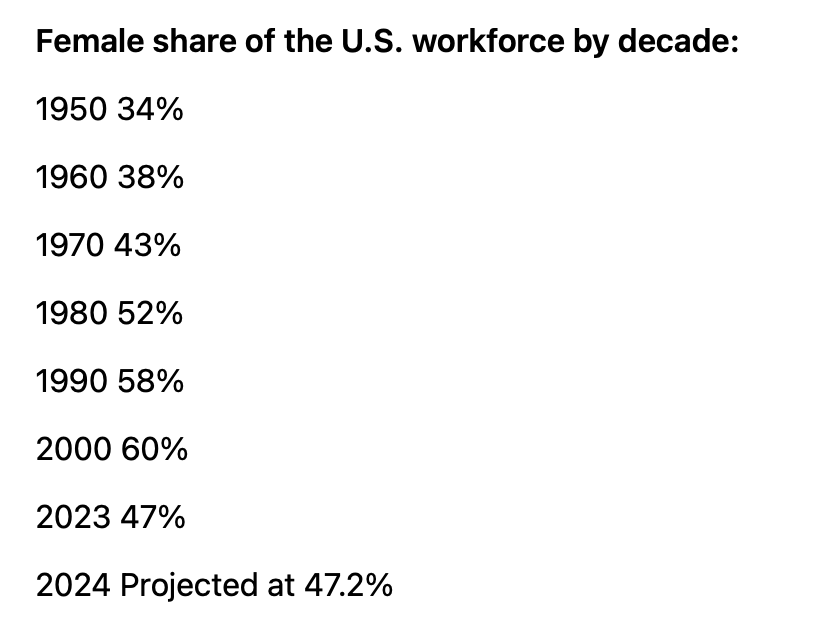
Find your tribe: the power of community in achieving your goals.
February 22, 2024
The Neuroscience of Narrative: The Power of Stories to Change Our Lives
April 23, 2024
March is Women’s History Month, so I want to highlight the amazing accomplishments of women in the workplace in U.S. history. While we’ve come a long way, women’s representation in corporate leadership and CEO roles shows both promise and also areas where growth is still needed.
As of 2024, here’s a summary of the current landscape of women in the workforce in the U.S.:
Women’s Representation in the Workplace:
· Women comprised 47% of the U.S. labor force in 2023, a significant increase from just 34% in 1950. However, this growth has plateaued in recent years, down from the peak of 60% in late 1999.

Leadership Positions:
· Only 11% of the CEOs of Fortune 500 companies and 6.6% of CEOs in S&P500 companies were women as of 2023.
· While this share of the CEO role does reflect progress, it also shows a considerable gap in representation at the highest corporate levels.
· For instance, up to 28% of leaders in the C-Suite were women in 2023 according to a comprehensive McKinsey survey.
· The percentage of new female CEOs was 26.1% in October 2022, indicating a slow but ongoing trend towards gender diversity in top executive roles.
· However, women are taking an increasing role in managerial and professional occupations. The share of women in those jobs was just 31% in 1968, grew to 52% in 2013, and estimated to be 54% as of 2023.
Pay Disparity:
· Unfortunately, there still remains a significant gender pay gap among CEOs. In 2020, women in C-suite roles earned up to 25% less than their male counterparts, a gap that has persisted over the years.
Progress in Different Industries:
· Some industries show more gender equality than others. For example, 50% of the CEOs in the healthcare insurance industry are women, and the tech industry continues to include a commendable share of women.
· This data reflects a landscape where progress has been made, but significant disparities remain, especially in the highest corporate positions and in terms of pay equity. The journey towards gender parity in leadership roles continues to be an area of focus and development.
Here’s a timeline with the significant milestones and events in the history of women in the workforce in the United States:

18th and 19th Century:
- Late 1700s – Early 1800s: Women begin working in textile mills and factories during the Industrial Revolution, mainly in low-paying and labor-intensive jobs.
- 1839: Sarah Bagley founds the Lowell Female Labor Reform Association to advocate for better working conditions and higher wages for women in factories.
- 1848: The Seneca Falls Convention in New York marks the beginning of the women’s rights movement in the United States, demanding women’s suffrage and equal rights, including economic opportunities.
- Late 19th Century: Women start entering professions such as teaching, nursing, and secretarial work, although they face discrimination and lower wages compared to men.
- 1889: Anna Bissell becomes the first female CEO in U.S. history with the Bissell Carpet Sweeper Company, a firm she founded along with her husband.

20th Century:
- 1900-1909: Pioneering female entrepreneurs became some of our country’s most prominent business owners.
- 1910: The Women’s Trade Union League is founded to advocate for better wages and working conditions for women workers.
- 1920: The 19th Amendment to the U.S. Constitution is ratified, granting women the right to vote. This empowers women to more actively and openly advocat for their rights in the workplace.
- 1940s: During World War II, millions of women enter the workforce to fill roles left vacant by men serving in the military. Rosie the Riveter becomes a symbol of women’s contribution to the war effort.
- 1940-1945: The percentage of working women rises nearly 10% during World War II.
- 1963: The Equal Pay Act is signed into law, prohibiting wage discrimination based on gender for equal work.
- 1964: Title VII of the Civil Rights Act is enacted, prohibiting employment discrimination based on race, color, religion, sex, or national origin.
- 1972 The first ever female CEO of a Fortune 500 company was hired when the Washington Post named Katherine Graham their top executive.
- 1980s: The number of women-owned businesses begins to rise significantly, with women becoming entrepreneurs in various industries.
- 1993: The Family and Medical Leave Act (FMLA) is signed into law, allowing employees to take unpaid leave for family and medical reasons, including childbirth and caring for a sick family member.

21st Century:
- 2009: The Lilly Ledbetter Fair Pay Act is signed into law, extending the statute of limitations for filing pay discrimination claims.
- 2010: The Affordable Care Act (ACA) is passed, providing women with access to affordable health insurance coverage, including maternity care.
- 2013: Sheryl Sandberg’s book “Lean In” sparks a national conversation about women’s leadership in the workplace and encourages women to pursue their career ambitions.
- 2017: GoBundance Women is founded by a unique group of women that came together in San Diego, Ca., including Kelly Resendez.
- 2020: The COVID-19 pandemic disproportionately affects women in the workforce, highlighting existing inequalities such as wage gaps, lack of paid leave, and caregiving responsibilities.

2023-2024:
- Women represent 47% of the total U.S. workforce as of 2023, 11% of CEOs, and 28% of those in the C-suite.
- Women now represent the fast-growing share of entrepreneurs and small business owners across America. There are now 13 million women-owned businesses in the U.S. and growing daily, representing 42% of all U.S. businesses!
- GoBundance Women continues to grow and thrive, helping thousands of vanguard women harness the power of connections to level-up their businesses and power-up their lives.
If you’d like to find out more about GoBundance Women and the great events and membership options available, just click here.
***
This timeline showcases the evolving role of women in the workforce and the progress made toward achieving gender equality in the United States.
However, challenges such as wage gaps, workplace discrimination, and balancing work and family responsibilities continue to persist, emphasizing the ongoing need for advocacy and reform.
Women are leading the way in 2024, so have a great Women’s History Month and thanks for sharing this content if you found it enlightening!



